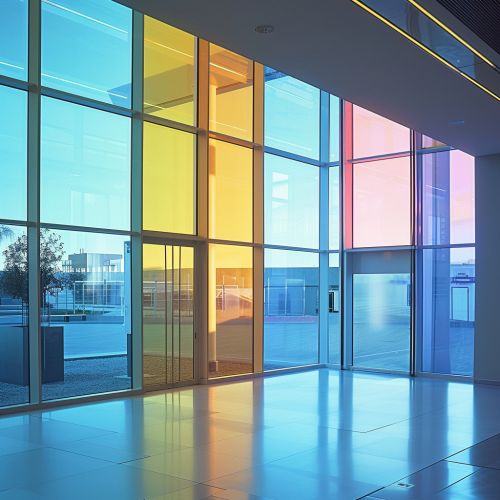Photochromic window
Introduction
A photochromic window is a type of window that changes its light transmission properties in response to light. The term 'photochromic' comes from the Greek words 'photo' meaning light and 'chroma' meaning color. This technology is used in various applications, from eyewear to architectural windows, offering a dynamic solution to control light and heat in buildings.


History
The concept of photochromic materials dates back to the early 20th century, but it wasn't until the 1960s that the first commercial applications were introduced. The development of photochromic windows has been driven by the need for energy-efficient solutions in architecture and the desire to improve comfort and convenience for building occupants.
Principle of Operation
Photochromic windows operate based on the principle of photochromism. This is a reversible process where a chemical substance changes its color when exposed to light. The change is usually from a clear to a colored state. The intensity of the color change in a photochromic window depends on the intensity of the light. When the light source is removed, the photochromic material returns to its original, clear state.
Composition
Photochromic windows are typically made of a glass or plastic substrate that is coated with a thin layer of photochromic material. The most common types of photochromic materials used are organic compounds such as spirooxazines, naphthopyrans, and chromenes. These compounds have the ability to absorb light and undergo a chemical reaction that changes their color.
Applications
Photochromic windows have a wide range of applications. They are used in residential and commercial buildings to control the amount of light and heat that enters a space. This can help to reduce energy consumption for heating, cooling, and lighting. Photochromic windows are also used in vehicles to reduce glare and improve visibility. In addition, they are used in certain types of eyewear, such as sunglasses and safety glasses, to protect the eyes from harmful UV rays and reduce eye strain.
Advantages and Disadvantages
Photochromic windows offer several advantages. They can automatically adjust to changing light conditions, eliminating the need for manual adjustments or blinds. They also provide a high level of comfort by reducing glare and maintaining a consistent level of light in a room. Furthermore, they can contribute to energy savings by reducing the need for artificial lighting and air conditioning.
However, there are also some disadvantages to consider. Photochromic windows tend to be more expensive than traditional windows. They also have a slower response time compared to other types of smart windows, such as electrochromic windows. Additionally, the color change in photochromic windows is dependent on the intensity of the light, which means they may not provide the desired level of shading in all conditions.
Future Developments
Research and development in the field of photochromic windows is ongoing, with the aim of improving their performance and reducing their cost. One area of focus is the development of new photochromic materials with faster response times and a wider range of color changes. Another area of interest is the integration of photochromic windows with other building systems, such as lighting and HVAC, to create a more comprehensive solution for energy efficiency.
